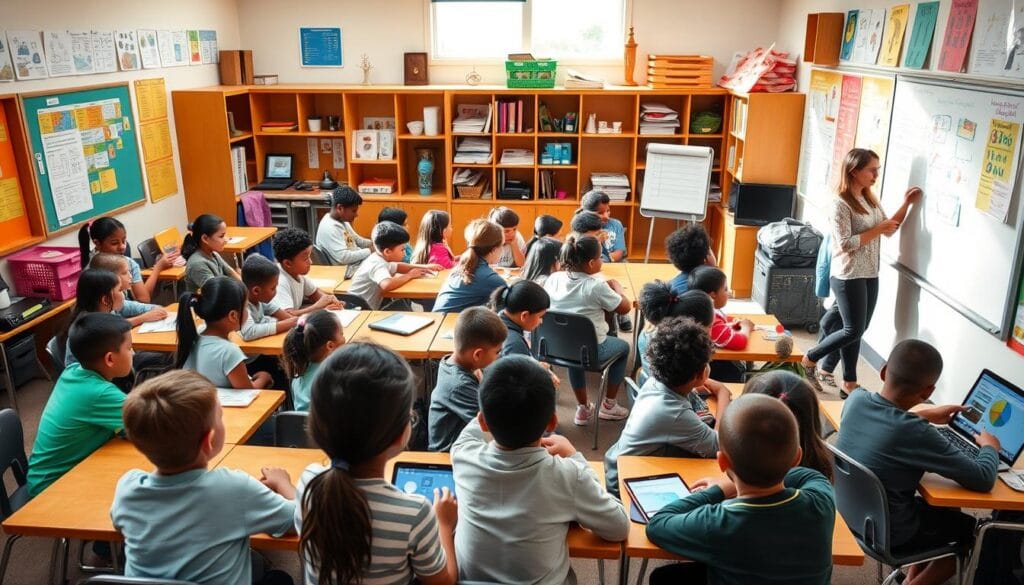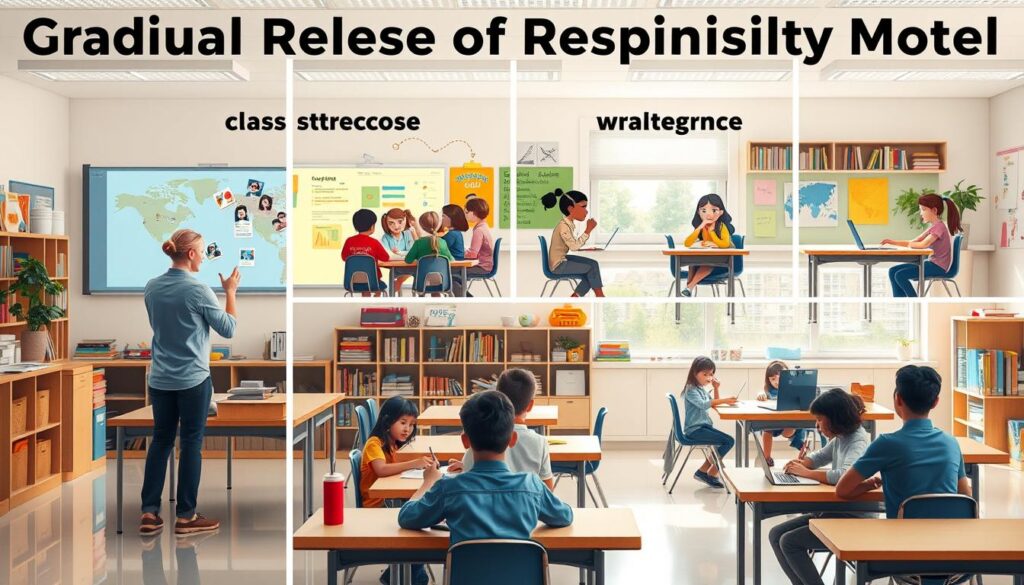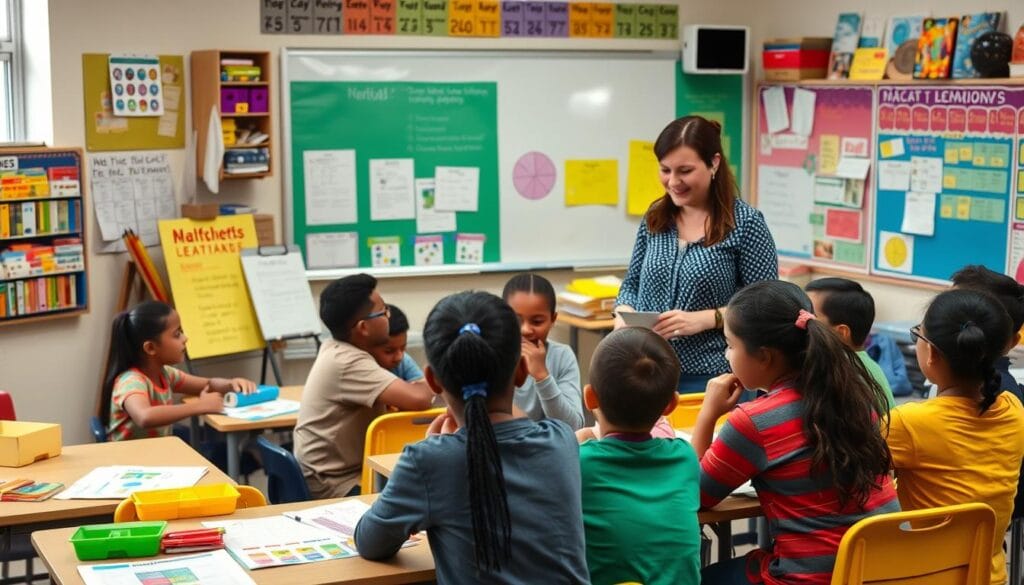Scaffolding in Education Explained
Education can be tough to navigate, but scaffolding helps a lot. It’s when teachers give students support as they learn new things. This support makes learning easier by breaking down hard tasks into simple steps.
Teachers use scaffolding in many ways to help students. It’s great for students of all levels and subjects. If you’re a teacher or a parent, learning about scaffolding can really help your students grow.
فهرس المقالة
Understanding the Fundamentals of Educational Scaffolding
Scaffolding is a key teaching method that helps students learn more than they can alone. It gives temporary support and guidance. This helps students tackle tough tasks and concepts, leading to greater independence and mastery.
Key Components of Scaffolding in Learning
Effective scaffolding includes several important parts:
- Assessing student’s current knowledge and skills
- Identifying the zone of proximal development (ZPD) – the gap between what a student can do alone and with help
- Tailoring instruction and support to meet the student’s specific needs within their ZPD
- Gradually releasing responsibility as the student gains competence and confidence
- Fostering active engagement and collaboration throughout the learning process
The Educational Theory Behind Scaffolding
Scaffolding is based on Lev Vygotsky’s work and the zone of proximal development. Vygotsky said students learn best when they’re challenged but not too hard. They need a guide or peer to help. This approach, focusing on social interaction and learning, is at the heart of scaffolding.
Benefits for Students and Teachers
Using scaffolding in the classroom has many benefits for students and teachers:
- Students become more engaged, motivated, and confident when tackling tough tasks with the right support
- Scaffolding helps students develop critical thinking, problem-solving, and self-regulation skills
- Teachers get to know their students’ learning needs better, allowing for personalized instruction and support
- The gradual release of responsibility helps students become independent learners, needing less teacher help over time
By grasping the basics of educational scaffolding, teachers can create engaging learning spaces. These spaces help students succeed and keep learning for life.
The Role of Scaffolding in Education: A Comprehensive Overview
Scaffolding is a key teaching method that helps all kinds of learners. It uses differentiated instruction to meet each student’s needs. This makes learning fun and inclusive for everyone.
At the core of scaffolding is instructional support. Teachers use scaffolding to help students grow. They start with simple tasks and gradually add more challenges. This helps students become independent and succeed in school.
Scaffolding includes many strategies like modeling and asking questions. Teachers adjust these methods to fit each student’s learning style. This approach boosts confidence and helps students do better in school.
“Scaffolding is the temporary support given to a student to assist them in completing a task that they could not do independently.”
Scaffolding is also key for differentiated instruction. Teachers use it to tailor lessons to each student’s level and interests. This way, students can learn at their own speed, leading to better results and a more enjoyable learning experience.
In short, scaffolding is very important in education. It helps create a supportive learning space. With scaffolding, teachers can help students achieve great things. It makes learning a journey of growth and discovery.
Implementing Zone of Proximal Development in Learning
The zone of proximal development (ZPD) is key in educational scaffolding. It helps tailor instruction to each student’s learning needs. By knowing a student’s ZPD, teachers can offer the right amount of help and support.
Identifying Student Readiness Levels
To start with ZPD-based scaffolding, teachers need to check the student’s current knowledge and skills. They use classroom observations, formative assessments, and talks to find out the student’s zone of proximal development. This lets teachers create guided learning that challenges the student but doesn’t overwhelm them.
Creating Optimal Learning Challenges
After finding out the student’s readiness level, teachers design tasks that fit their ZPD. These tasks should push the student to grow but not make them feel stuck or frustrated. By picking or changing the content and support, teachers help students feel accomplished and keep learning.
Measuring Progress Within the ZPD
It’s important to watch how students are doing with ZPD-based scaffolding. Teachers use ongoing assessments, observations, and talks to see how students are growing. This helps teachers adjust the scaffolding to keep students moving forward in their zone of proximal development.
“The most effective learning occurs when the learner is working within their zone of proximal development, with the appropriate level of support from a more knowledgeable other.”
Essential Instructional Support Strategies for Educators

As an educator, it’s key to offer effective support to help students succeed. Two important strategies are instructional support and metacognitive strategies.
Instructional support includes many techniques to help students learn. This includes showing them how to behave, asking questions to deepen their understanding, and giving specific feedback. By breaking down hard tasks and guiding students, teachers help them grow and feel more confident.
Metacognitive strategies help students take charge of their learning. They learn to reflect on their own learning, set goals, and develop strategies. This way, students can adapt to challenges and own their educational path.
| Instructional Support Strategies | Metacognitive Strategies |
|---|---|
|
|
Using both strategies, educators can build a supportive learning space. This space helps students develop skills and self-awareness for academic success.

“The most effective teachers are those who can seamlessly integrate instructional support and metacognitive strategies into their daily practice, tailoring their approach to the unique needs of each student.”
Differentiated Instruction Through Scaffolding Methods
Effective differentiated instruction is key for meeting students’ diverse learning needs. By using scaffolding in education, teachers can adjust content and support levels. They also use assessments that fit different learning styles.
Adapting Content for Various Learning Styles
Understanding how students learn is crucial. Some do well with visuals, others with hands-on activities, and some with sounds. Teachers use various methods to help each student learn in their best way.
Personalizing Support Levels
Scaffolding lets teachers give specific help to students. They gradually give more independence as students grow. This might mean breaking down big tasks, giving feedback, or extra resources. Personalized support helps students reach their best.
Assessment Techniques for Differentiated Learning
- Formative assessments to check progress and adjust teaching
- Flexible performance tasks for different ways to show understanding
- Student self-reflection and goal-setting
- Portfolios to show student growth over time
Using different assessment strategies helps teachers see how each student learns. This lets them choose the best teaching methods.
“Differentiated instruction is not a single strategy, but rather an approach to teaching that advocates active planning for student differences.”
By following differentiated instruction and scaffolding in education, teachers can make learning environments where all students can succeed.
Gradual Release of Responsibility Model in Practice
The Gradual Release of Responsibility Model is a key method in education. It helps students become more independent and skilled. This model guides students from being fully taught by the teacher to learning on their own.
This model has four main stages:
- Direct Instruction: The teacher leads, giving clear instructions and showing how to do things.
- Guided Practice: The teacher helps as students start to understand, offering feedback and support.
- Collaborative Learning: Students work in groups, using what they’ve learned to solve problems, with the teacher helping.
- Independent Practice: Students learn on their own, showing they can handle the material without help.
Using this model, teachers create a supportive learning space. It helps students become self-reliant and critical thinkers. This method boosts their academic success and teaches important life skills like problem-solving and decision-making.

“The Gradual Release of Responsibility Model is a powerful tool for educators, as it allows them to systematically guide students towards independent learning and skill mastery.”
Teachers follow this model’s stages to support students. They help students grow in confidence and skill, making learning easier and more effective.
Cognitive Apprenticeship and Metacognitive Strategies
Scaffolding in education does more than just help students. It also boosts critical thinking and self-learning skills. This part looks at cognitive apprenticeship and metacognitive strategies, key parts of good scaffolding.
Building Critical Thinking Skills
Cognitive apprenticeship teaches students to solve real problems like an apprentice learns from a master. Teachers show how to think and make decisions in a task. This helps students learn to solve complex problems on their own.
Developing Self-Regulated Learning
Metacognitive strategies make students take charge of their learning. They learn to track their progress, set goals, and change their learning methods. This way, they understand the material better and own their learning journey.
Monitoring Student Progress
Good scaffolding means always checking and adjusting help levels. Teachers watch how students do and adjust teaching methods as needed. This ensures students get the right amount of help to become more independent learners.
Using cognitive apprenticeship and metacognitive strategies helps teachers. It lets students think critically, learn by themselves, and do better in school.
“Scaffolding is not just about providing support; it’s about empowering students to become independent, self-directed learners.”
Real-World Applications and Success Stories
Scaffolding in education has shown amazing results in real classrooms. Teachers and schools all over are using this method to change how students learn. It helps students at every level.
At Lincoln Elementary School, teachers used scaffolding to help students grow. They focused on what each student could learn with a little help. This led to a 20% jump in grades in just one year. Students not only got better at understanding things but also felt more confident and skilled at solving problems.
Oakwood High School’s English teachers also saw great results. They used a method where students learn to do things on their own. This led to a 15% rise in test scores and better critical thinking skills.
| Institution | Scaffolding Strategies Implemented | Measurable Outcomes |
|---|---|---|
| Lincoln Elementary School | Identified student ZPD, tailored instruction | 20% increase in academic performance |
| Oakwood High School English Department | Gradual release of responsibility model | 15% increase in standardized test scores, improved critical thinking |
These stories show how scaffolding in education can change lives. With the right support, teachers can help students reach their full potential. This leads to better understanding, problem-solving skills, and a love for learning that lasts a lifetime.

Conclusion
In this article, we’ve seen how scaffolding techniques change education. We’ve looked at what educational scaffolding is and how it works. We’ve also seen how it helps students and teachers.
Thinking about what we’ve learned, it’s clear that scaffolding techniques are key to good teaching. They help students learn by giving them the right support. This makes them better at school and more interested in learning.
The future of scaffolding techniques in schools looks bright. New ways of teaching will come up, making learning even better. Try using scaffolding in your teaching. See how it can help your students grow and succeed.
FAQ
What is scaffolding in education?
Scaffolding in education is a teaching method. It gives students temporary help and guidance as they learn new things. It helps them become independent learners and master new concepts.
How does scaffolding support student learning?
Scaffolding breaks down hard tasks into easy steps. It offers support and then slowly lets students do it on their own. This helps students learn at their own pace and tackle challenges with the right amount of help.
What are the key components of effective educational scaffolding?
Good educational scaffolding starts with knowing when students are ready. It creates challenges that are just right for them. It also tracks progress and uses strategies like modeling and feedback to help students.
How can scaffolding be used to support differentiated instruction?
Scaffolding helps with different learning needs by adjusting content and support. It makes tasks fit each student’s learning style. It also uses assessments that match different learning approaches.
What is the Gradual Release of Responsibility Model, and how does it relate to scaffolding?
The Gradual Release of Responsibility Model is like scaffolding. It moves from teacher-led to student-led learning. It helps students learn to work on their own as they gain skills and confidence.
How can scaffolding incorporate cognitive apprenticeship and metacognitive strategies?
Scaffolding can use cognitive apprenticeship and metacognitive strategies to improve learning. Cognitive apprenticeship teaches critical thinking. Metacognitive strategies help students understand and control their learning. Together, they help students develop skills for lifelong learning.






